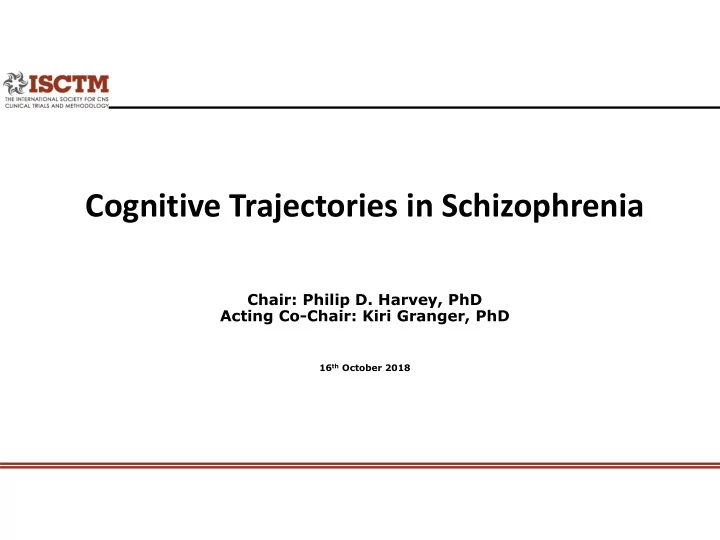

Cognitive Trajectories in Schizophrenia Chair: Philip D. Harvey, PhD Acting Co-Chair: Kiri Granger, PhD 16 th October 2018
Cognitive Trajectories in Schizophrenia • The focus of this workshop is on baseline cognitive and subsequent treatment response in schizophrenia • The trajectory is a post treatment trajectory, of response or failure to respond • We want to thank Michael Sand for proposing this working group and hope to see him at the next meeting
Baseline Impairment and Cognition Treatment Trials • Buchanan et al. 2005: Question 7 : MINIMUM LEVEL OF IMPAIRMENT. In order to detect a therapeutic effect, should a minimum level of cognitive impairment be specified in the inclusion criteria? • Answer to Question 7 : MINIMUM LEVEL OF IMPAIRMENT. There is insufficient evidence to exclude patients who perform well, but not at or near ceiling.
What was the typical Level of Cognitive Impairment Seen? 30 25 20 15 Schizophrenia (n=575) Normal controls (n=540) 10 5 0 <50-50 51-60 61-70 71-80 81-90 91-100 101-110 111-120 121-130 131-140 140+ -5 r-BANS scores in HC and SCZ patients Wilk CM, et al. Schizophr Res. 2004;70(2- 3):175-186. Mean score=70.
What is the level of impairment seen in SCZ patients in MATRICS-Informed Clinical Trials? • Georgiades et al., 2017 • 2616 stable outpatients • 15 clinical trials • Tested with the MCCB
Performance by MCCB Domain t-Score 45 40 35 30 25 20 15 10 5 0 Proc Speed WM Attn Verb L Vis L Reason Comp AVG t-Score Note. Mean= 50, SD= 10, 30 is equivalent to IQ-based score of 70. AVG= Mean of Subscales, Comp is normed composite
How Many Cases Not impaired • Assuming a 1.0 SD criterion for impairment and a normal distribution (presented as t- Scores) – Mean of 30 17% unimpaired – Mean of 35 27% unimpaired
How Clinically Meaningful is a cut-off of 40? • Examined 554 clinically stable outpatients with the MCCB and informant ratings of everyday functioning – Social – Vocational – Everyday Activities • Divided sample into patients with t scores of 41 or more (“neuropsychologically normal”; n=187) and scores of 40 or less, n=367
Pearson Correlations between Everyday Functioning and NP Performance 0.6 0.5 0.4 0.3 0.2 0.1 0 Social Vocational Activities Total Sample NP Normal
Post-hoc analysis of Phase II CIAS Trial What’s the challenge? • Patients with schizophrenia show substantial variability in cognitive performance • CIAS trials screen out the severely impaired but not the unimpaired • Up to a quarter can perform within a clinically normal range which may: • Inflate baseline scores • Minimise change to detect positive drug effect Investigation by post-hoc analysis of a multi-national Phase II CIAS trial: Aim: Explore participant-level trajectories of cognitive performance to examine degree and range of scores Participants: 463 patients who met DSM-5 diagnosis for schizophrenia, clinically stable (non-acute), no more than moderate severity ratings on PANSS Study Design: 12 weeks; CANTAB and MCCB assessed at screening, baseline, week 6, week 12 Analysis: Participant data were pooled across treatment and placebo groups from screening to week 12. Analysis involved exploring trajectories of cognitive performance to determine whether performance stability over time was associated with screening/baseline scores
25% of patients were not ‘clinically’ impaired Approx. 25% of patients enrolled performed within a normative range (t score > 35-40) Those performing within a clinically normal range on MCCB were also those performing within the normal range on CANTAB PAL (top 25%, <10 errors) Granger et al., 2018
25% of patients were not ‘clinically’ impaired Approx. 25% of patients enrolled performed within a normative range (t score > 35-40) This result was found across both MCCB and Those performing within CANTAB tests a clinically normal range on MCCB were also those performing within the normal range on CANTAB PAL (top 25%, <10 errors) Granger et al., 2018
Poorer performers improved over the course of the trial Granger et al., Presented at International Society for CNS Clinical Trials and Methodology (ISCTM), 2018 CANTAB PAL scores for individual participants plotted over time, colour coded by their score at screening. Lower scores indicate better performance. Orange lines: individuals who scored <10 errors at screening; blue lines: individuals who scored >10 errors at screening. • Poorer performers (bottom 75%): Improvement over visits • Top performers (top 25%): No change in performance over visits
Patient selection or stratification? • High cognitive performers at screening and baseline may be less likely to demonstrate cognitive change over the course of a trial 1) Stratification at screening : high and low cognitive performers in each treatment arm to identify responders? 2) Pre-screen for cognitive impairment: define inclusion criteria to establish cognitive performance at screening/baseline?
What about regression to the mean and practice effects? • Retest performance tends to change toward the mean • Higher scorers would be expected to perform lower with no treatment • Practice effects may offset this • Practice effects may be higher in better performers
Placebo/Practice effects • Keefe et al., 2017 • 813 SCZ patients receiving placebo in MCCB trials • Retest effect: 0.73 t-score points per reassessment • Prescreening changes=Post baseline changes • Predictors of Practice effects: – More Motivation – Greater depression
What are the issues? • Are patients entering enhancement trials more likely than the overall population of have NP normality? • Is this effect large enough to be concerned about? • Does this reduce the chances of improvement? • Would we bias the data if we had an entry criteria?
Recommend
More recommend